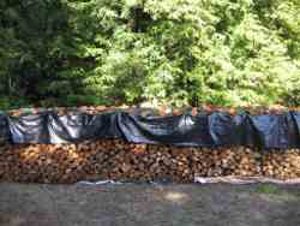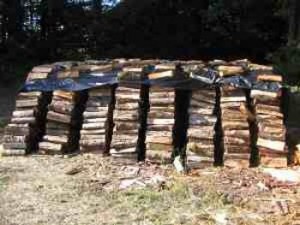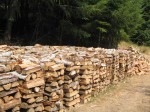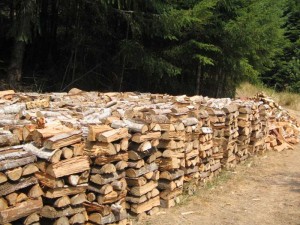Why Stack Firewood?
When you get a load of firewood the natural thing to do is stack it. But why do we stack it instead of leaving it in a big heaping pile? Although you could leave it in a pile, there are advantages to stacking firewood.
Firewood stacking is a good way to get your firewood off the ground and in a position where it can get good air circulation. This will allow it to dry faster, help it stay dry,and makes it easier to cover. Stacked firewood also takes up less space than a random pile and looks nicer. More about how to season firewood.
Firewood Stacking
Firewood stacking may seem like a simple job, and it is, but learning how to stack firewood can give you better quality firewood to burn and save you from a lot of unneeded work and potential problems.
Where to Stack Firewood
Stacking your firewood in the right place can save you a lot of work and help your wood dry. If your wood is green or wet, the best place to stack it is outdoors where it can be exposed to the sun. If it is dry, it’s best to stack it under cover in a shed, lean-to or other structure that is well ventilated. Covering firewood with a tarp works too when done properly.
If your firewood is wet or green, you can still stack it indoors, just be sure the structure has good air flow so it can dry. And know it may take longer to dry than if it was out in the sun.

If your wood is dry, and you don’t have a structure to put it in, you can stack it outdoors and cover it with a tarp or plastic sheeting, or other material to keep it dry. Just make sure you cover it in a way that allows air flow. Leave the sides of the stack exposed to the open air. If you put a tarp over the whole pile all the way to the ground it will hold in moisture.
See why covering your wood with metal roofing is a great way to keep it dry.
In selecting a place for your firewood keep in mind how convenient it will be to bring in to burn. Consider that it will probably be there a while and think of things you might be doing later and whether it might be in the way.
Check with local building and fire codes, in some areas outdoor firewood is recommended or required to be stored a certain distance from structures for fire safety.
How to Stack Firewood
When firewood stacking you will want to keep it off the ground. If you are stacking it on a hard floor or concrete slab that is fine but you can put stickers down to help air flow under the stack. If you are stacking it directly on the ground you will definitely want to put something on the ground first to keep the wood away from soil contact. Two parallel 2×4’s or similar objects placed the length of the firewood apart work great.

If you are stacking against a wall, fence or other structure leave a few inches space to allow air flow. Also if you are making multiple stacks keep a few inches of space between the stacks.
Start stacking the pieces fitting them together as tightly as you can to make the pile stable. Notice the taper of the wood and invert the pieces so thick ends can be next to thin ends as needed so the pieces fit together well. Stack the pieces with the ends as even as you can to ensure a vertical stack. For a more stable stack keep the it no more than 4′ high or it could become unstable and fall over.
If you have a firewood rack or stakes at the ends or something to stack the ends against this will help you get nice vertical ends to your stack. If not you can criss-cross flat edged pieces like a log cabin on the ends to make them vertical. Otherwise you can just slope the ends but make sure the slope isn’t too steep or you may end up with a firewood avalanche. This can be dangerous especially if there are small kids or pets around. How to build a firewood rack that is simple and inexpensive.
Keep in mind that wood shrinks as it dries and the stacks may shift some over time. If one side gets sun exposure that side will shrink faster and can cause the stack to lean in that direction. When stacking green wood you may want to stack it so it leans a little away from the sun to compensate. Same with stacking against a wall or against other stacks. The out facing side of the stack will often dry faster and lean away toward the open space.
Keep safety in mind when firewood stacking and know that woodpiles can fall over. Keep children off of them.

